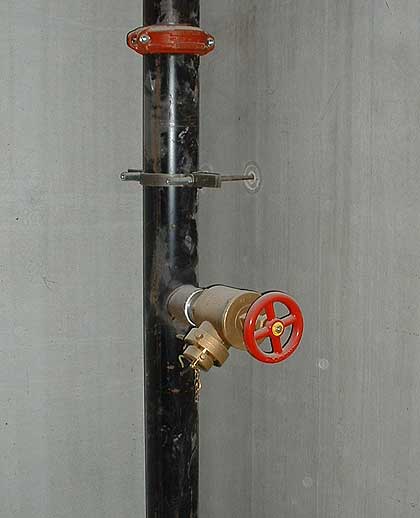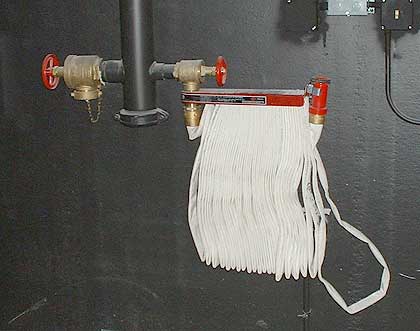Fire Suppression Services Incorporated
Fire Suppression Systems, Fire Alarm Systems, Portable Fire Extinguishers, Restaurant Fire Suppression Systems, FM 200 Fire Suppression Systems, Ansul, PyroChemNFPA 14
Stand Pipe examples
It is very important to know the different types and proper operation of the types of stand pipes that might be found at a premises.There are FOUR types of Stand Pipe:
- One Wet and Three Dry.
- Class I [2-1/2" (64mm) hose connections]
- is used by FireFighters who have training in the handling of high velocity / high pressure water streams.
- Class II [1-1/2" (38mm) hose lines]
- is used by occupants with no training
- Class III [1-1/2" (38mm)] and [2-1/2" (64mm)] hose connections
- is used by those trained in the handling of high velocity / high pressure water streams.
The International Fire Code states that a Class III standpipe system shall be installed throughout
buildings where the floor level of the highest story is located more than 30 feet above the lowest level of fire department access,
or where the floor level of the lowest story is located more than 30 feet below the highest level of fire department access.
The Code also requires a Class I, II, or III standpipe in non-sprinklered Group A buildings having an occupant load exceeding 1,000 persons,
covered malls, stages, underground buildings, helistops, heliports, marinas, and boatyards.
- is used by those trained in the handling of high velocity / high pressure water streams.
| Class One Note the brace to the wall |  |
| Class Two |  |
Inspection & Maintenance
Fire hose stations should usually be inspected or checked every 90 days (or as specified by local AHJ).The business owners or building occupants are responsible for making sure that the fire hose station is regularly checked and maintained.
Fire hose stations will not be an effective fire-fighting tool if they are not properly maintained and inspected for quality assurance.
Review the check list below to identify key concerns with the fire equipment and contact local fire authorities if a repair is needed.
- Are the operating instructions legible?
- Does the cabinet appear to be intact with no cracks or breaks in the glass?
- Is the cabinet door easy to open?
- If a locked cabinet is installed, does the lock function properly?
- Will the hose rack swing out at least 90° from the cabinet?
- Are any safety seals broken or missing?
- Is there any obvious damange or corrosion to the hose valve?
- Is the valve handle missing?
- Does the hose appear to be folded neatly on the hose rack?
- Is the hose conneted to the rack nipple or valve?
- Is the hose intact with no breaks, holes, or tears?
- Is the hose nozzle missing?
- Are all warning labels and tags free from damage?
- Are all the valves, hose nozzles, fire extinguishers, etc. easily accessible?
or your local fire department for more information about standpipe fire hose station inspection and maintenance.
[Top]
|
(801) 277-6464 |
